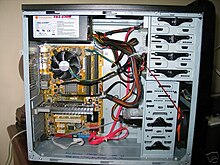Personal computer hardware
It has been suggested that Peripheral be merged into this article. (Discuss) Proposed since May 2007. |
It has been suggested that Peripheral device be merged into this article. (Discuss) Proposed since May 2007. |
Computer hardware is the physical part of a computer, including the digital circuitry, as distinguished from the computer software that executes within the hardware. The hardware of a computer is infrequently changed, in comparison with software and data, which are "soft" in the sense that they are readily created, modified or erased on the computer. Firmware is a special type of software that rarely, if ever, needs to be changed and so is stored on hardware devices such as read-only memory (ROM) where it is not readily changed (and is, therefore, "firm" rather than just "soft").
Most computer hardware is not seen by normal users. It is in embedded systems in automobiles, microwave ovens, electrocardiograph machines, compact disc players, and other devices. Personal computers, the computer hardware familiar to most people, form only a small minority of computers (about 0.2% of all new computers produced in 2003). See Market statistics.
Typical PC hardware
A typical Personal computer consists of a case or chassis in a tower shape (desktop) and the following parts:



The motherboard is the "heart" of the computer, through which all other components interface.
- Central processing unit (CPU) - Performs most of the calculations which enable a computer to function.
- Computer fan - Used to lower the temperature of the computer; a fan is almost always attached to the CPU, and the computer case will generally have several fans to maintain a constant airflow.
- Random Access Memory (RAM) - Fast-access memory that is cleared when the computer is powered-down. RAM attaches directly to the motherboard, and is used to store programs that are currently running.
- Firmware usually Basic Input-Output System (BIOS) based or in newer systems Extensible Firmware Interface (EFI) compliant
- Internal Buses - Connections to various internal components.
- External Bus Controllers - used to connect to external peripherals, such as printers and input devices. These ports may also be based upon expansion cards, attached to the internal buses.
A case that holds a transformer, voltage control, and (usually) a cooling fan, and supplies power to the rest of the computer.
Storage controllers
Controllers for hard disk, CD-ROM and other drives like internal Zip and Jaz conventionally for a PC are IDE/ATA; the controllers sit directly on the motherboard (on-board) or on expansion cards, such as a Disk array controller. IDE is usually integrated, unlike SCSI which is found in most servers. The floppy drive interface is a legacy MFM which is now slowly dissappering. All these interfaces are gradually being phased out to be replaced by SATA and SAS.
Produces the output for the computer display. This will either be built into the motherboard or attached in its own separate slot (PCI, PCI-E or AGP), in the form of a Graphics Card.
Removable media writer
- CD - the most common type of removable media, inexpensive but has a short life-span.
- DVD
- Blu-ray
- Floppy disk (outdated)
- Zip drive (outdated)
- USB flash drive - AKA a Pen Drive, a portable form of storage.
- Tape drive - mainly for backup and long-term storage.
Internal storage
Hardware that keeps data inside the computer for later use and remains persistent even when the computer has no power.
- Hard disk - for medium-term storage of data.
- Solid state drive - similar in use to a hard disk, but using more recent technology.
- Disk array controller - a device to manage several hard disks, for example to achieve performance improvement.
Enables the computer to output sound to audio devices, as well as accept input from a microphone. Most modern computers have sound cards built-in to the motherboard, though it is common for a user to install a separate sound card as an upgrade.
Connects the computer to the Internet and/or other computers.
- Modem - for dial-up connections
- Network card - for DSL/Cable internet, and/or connecting to other computers.
Other peripherals
In addition, hardware can include external components of a computer system. The following are either standard or very common.

Includes various input and output devices, usually external to the computer system
